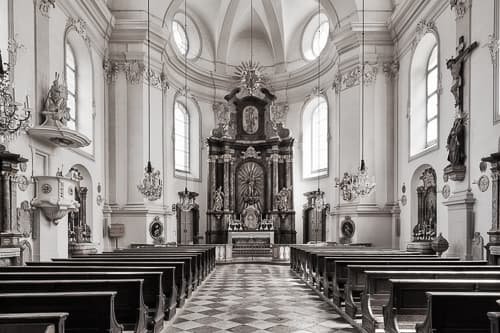Making Photos: What's the Art to Taking Great Travel Pics?
Making photos of the interior of St. Sebastian's Church in Salzburg, Austria.
Do you struggle when making photos and do you wish your own travel pics were better quality and related more authentically to your own life’s journey? This post offers a great starting point, with easy to action tips to accelerate your own creative journey through photography.
There’s an art to making photos that doesn’t have to involve an arts degree or wacky post processing to create great travel pics. What’s needed is an eye for light and composition; an ability to interact with people; sound technical skills; and an ability to anticipate and respond to the moment.
Have you ever had trouble making photos? Perhaps you were tired or uninspired. Maybe the weather was bleak or the light uninteresting.
Despite the best intentions, and a desire to make great travel pics, you found yourself unable to see an interesting subject or composition you felt was worth photographing.
Let’s explore some simple ways to overcome all those problems and help you on your journey to making photos that will provide you with personal fulfillment and, at the same time, inspire your audience through your own, unique vision and world view.
Making Photos in St Sebastian’s Church, Salzburg
The photos in this post were made in the lovely St. Sebastian’s Church and Cemetery in Salzburg, Austria.
The light levels inside the church were low, yet the dynamic range inside the church and the adjoining cemetery was high.
As well as holding the camera very still, to avoid camera shake, I had to position myself in such a way that minimized the high levels of contrast between the lightest and darkest parts of the scene.
Failure to do so would have resulted in a loss of important highlight and shadow detail from the scene.
As you can see in the interior view of St. Sebastian’s Church, published at the very top of this post, the composition includes both very dark and very light areas. Yet, despite the high dynamic range, the photo itself displays quite acceptable levels of highlight and shadow detail.
Fortunately, the angle of the windows helped prevent a complete loss of highlight detail. Similarly, there’s sufficient detail and shape in the dark altar and statues, in the centre of the frame, that draw the eye away from the even darker tones present on the backs of many of the church pews.
Many of those dark tones actually help to shape the church pews and altar, while the lightest tones, while they lack detail, emphasize the shapes of the windows.
As a final touch, I added a subtle warm tone to this black and white rendering to emphasize the feeling of tranquility I experienced in the beautiful St. Sebastian's Church.
Having an understanding of contrast, and your camera’s ability to maintain detail in bright highlights and dark shadows, is key to making photos under high dynamic range conditions.
It takes practice but, when mastered, is what enables you to free yourself from such concerns and allow you to concentrate your attention on the more creative aspects of making photos.
Pointing your camera at a scene and simply clicking the button really won’t do. Not if you want to elevate making photos to the next level and beyond.
Travel pic of Mary and Jesus Statue, St. Sebastian's Church, Salzburg, Austria.
Better Travel Pics: Try This Simple Tip
There’s no doubt that a tripod would have allowed me to easily avoid camera shake due to the low light levels in the church while, simultaneously, reducing the dynamic range of the scene through a HDR (i.e., High Dynamic Range) sequence of images.
However, as I didn’t have a tripod with me, it made sense to concentrate my camera’s attention on scenes with a lower dynamic range.
Fortunately, there were several beautiful details throughout the church that suited my needs perfectly.
The above image of the statue of Mary, holding the baby Jesus, was one such example.
Their elevated position, above the congregation, was no doubt designed to emphasize their revered status to the faithful.
It could certainly be argued that the lines and textures within the statue would make it a great candidate for rendering into black and white. However, as gold is such an evocative color, I’ve resisted the urge, at least for now.
However, as it’s a basically monochromatic scene, I believe I could achieve a more three dimensional result in black and white, perhaps with the addition of a heavy warm tone for added mood.
Making photos of the altar at St. Sebastian's Church in Salzburg, Austria.
Making Photos: why Wanting It To Happen Isn’t Enough
The moral of the story is that it takes more than just being there with your camera at the ready to make great trips pics.
Wanting to make a great photo just isn’t enough. Sometimes you have to look hard to find the subject and work to make a composition that’s both interesting and that serves the technical (e.g., dynamic range) needs of the image in question.
Making Photos: Details Speak Of Larger Things
One way to do so is to minimize clutter within the frame. It’s okay to think global, but by concentrating on local elements within the large scene you can often find a way to explore bigger issues.
Here’s some examples:
Explore the forest by photographing a leaf or a stand of trees.
The face of a young child can speak to the wonder present within our world.
A pathway can suggest the hope that exists at the beginning of a journey.
Travel Pics Based Upon Contrast, Exposure and Detail
There’s no doubt that concentrating your attention on an interesting detail within the larger environment is a great way to minimize clutter in the frame.
This will allow you to concentrate your audience’s attention on the subject or message you’re wanting to explore.
Fortunately, these smaller details are often more evenly lit than is the case with larger scenes. This makes it much easier to manage contrast, achieve an acceptable exposure and reveal sufficient amounts of highlight and shadow detail in your travel pics.
As you can see that’s exactly what’s been achieved in this study of the altar at St. Sebastian’s Church in Salzburg.
It was the gentle light, diffused by the church windows, and the relatively low dynamic range that drew my attention to this colorful and highly detailed scene.
About To Travel?
Making Photos Along The Arcades At St Sebastian’s Cemetery
Exiting a door at the back of the church I found myself in the adjoining and historic St. Sebastian’s Cemetery.
Unfortunately, after a day and a half of pretty constant rain, the sun was blazing and I found myself making photos under even higher levels of dynamic range than I’d been dealing with indoors.
Built in the style of an Italian campo santo there are four corridors, called arcades, that surround the cemetery.
Fortunately, the arcade featured in this particular photo, was shaded from the much brighter outdoor sunlight. That fact immediately reduced the dynamic range of the scene to a range I could work with.
I remember positioning myself in such a way to exclude bright light from entering the composition, along the right hand side of the frame, and to emphasize the depth, detail and tonal range within the scene.
Despite the high dynamic range that results from very bright light, I was able to position myself in such a way to control the contrast of the scene while, at the same time, make a really interesting travel pic.
In fact, the tonal range I’ve achieved was so wide that the image became a clear candidate for rendering into black and white. And I’m really happy with the final result.
Travel Pics Tip: Making Photos is a Physical Endeavor
Next time you’re having trouble making photographs consider the detailed view as a way to explore larger ideas.
Look left, right, up and down. And, by all means, turn around. You never know what interesting or unique opportunities for great photos will appear when you do.
Photography is a physical endeavor and moving around an environment will ignite your creativity and help you discover the following:
New subject matter
Interesting perspectives
Elements of composition (e.g., shapes, lines, textures, color)
Inspirational light
Movement can mark the beginning of a great photograph. More often than not movement is the best thing you can do to turn a lacklustre moment into a creative opportunity.
“If you’re struggling to make a good photo, move yourself and/or move the subject.”
Making photos of headstones and plaques, St. Sebastian's Cemetery in Salzburg, Austria.
Conclusion: The Importance Of Light When Making Photos
Look at these beautiful headstones and plaques, sheltered from the weather and displayed along one of the four arcades surrounding the lovely St. Sebastian’s Cemetery in Salzburg.
I just love the luminous tones and warm, buttery colors in this highly detailed study.
You can see why verandah lighting is one of my favorite light sources. It’s simply gorgeous light for a travel photographer to be making photos under.
Whether you’re photographing portraits or creating still life images, verandah lighting will help you produce amazing results, no matter the weather.
Just be careful to compose your image in such a way that excludes big differences in relative brightness (e.g., very light and very dark areas within the same composition) from the scene.
Light is the most important consideration in photography. Paying attention to light and learning to utilize it, both creatively and to solve technical problems, is essential to learning the art of making photos.
That, more than anything else, is what most folks need to master on their journey to making really great travel pics.








